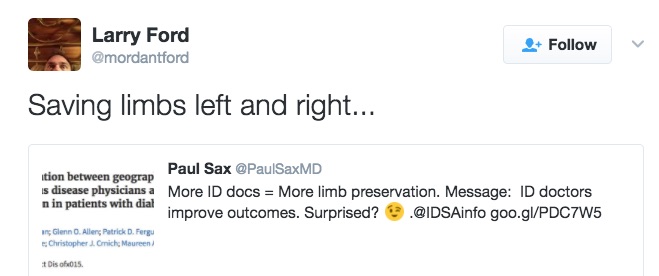An ongoing dialogue on HIV/AIDS, infectious diseases,
February 26th, 2017
Improving Outcomes with ID Consultation: Three More Papers For the Collection
 Several years ago, one of my very brilliant colleagues posed an interesting question.
Several years ago, one of my very brilliant colleagues posed an interesting question.
Why do ID specialists even exist?
“After all,” he said in an accent that happens to be a distinctive mix of several former British colonies. “There is nothing we do that other doctors couldn’t also do, provided they had the motivation.”
He had a point — with no required endoscopic tool, special catheter, expensive imaging device, or other arcane gizmo, the basics of ID clinical practice are available to everyone:
- Take a careful history. And I mean careful. Read this.
- Do a targeted exam. Self explanatory.
- Meticulously review the available data. OK, obsessively review it, to the point of almost meeting DSM criteria. Turn out the lights when you’re done, it’s getting late.
- Communicate with everyone. Go to radiology and review the films. Look at the ECHO with the cardiologists. Ask the surgeons what they saw in the OR, what they did, and why. Use your friends in the microbiology lab to make you look smart — same with the pathologist who interpreted that biopsy. Call the referring doctors to get their thoughts. Get permission to check with the wife or husband or sister or brother or son or daughter or friend about what they think is going on. If it’s some obscure infection, reach out to the local/national/international expert and find out what he or she would do. Folks, this stuff is gold.
- Put it all together. Voila, the assessment. Say what you think is going on, and why. Use all your internal medicine training, because not everyone with a fever or an elevated white blood count has an infection, not everyone with a red leg has cellulitis. Best if these impressions are relayed directly — in spoken words — to the consulting clinicians, and then concisely summarized in the note.
- Make clear recommendations. Start with the diagnostic tests, then the therapeutic recommendations. Put it in list form to make it easy to follow.
- Collect your big paycheck. Kidding.
Back to my colleague’s point — any clinician could do these things.
But since items #1-6 above are our standard operating procedure, and we want to justify our existence, there’s a growing body of literature that correlates care provided by ID doctors with better outcomes.
And recently we have three more to add to the pile:
- Infectious diseases specialist management improves outcomes for outpatients diagnosed with cellulitis in the emergency department. That’s the title of the paper, which sums up the findings nicely. In more detail, ID care was associated with lower likelihood of recurrence, of hospitalization, and receipt of less empiric broad-spectrum therapy. And here’s a bonus — the ID consultants “identified cellulitis mimickers allowing for care of the true issue.” Love that.
- The more ID doctors living in a region, the more likely a patient will avoid amputation for diabetic foot ulcers. I like the fact that the authors used “geographic density” of ID doctors, as this accounts for both formal ID consults and the informal advice given to clinicians, something we do frequently. How to summarize this benefit? Here’s one amusing way:

- In cryptococcal infection, ID consultation is associated with improved survival. In this retrospective cohort of non-HIV related cryptococcal disease, mortality was 27% for those with ID consultation, versus 45% for those without — even though patients with ID consults had a higher fungal burden and were more likely to have CNS disease. (Quick query — given the inevitable complexity of cryptococcosis, can you imagine not wanting an ID consult? Jeeze.)
A couple of final thoughts about these studies.
First, note that these three papers span very different aspects of ID cases — the routine (cellulitis), the common but complex (diabetic foot ulcers and osteomyelitis), and the rare but life-threatening (cryptococcal disease).
Second — aren’t we’re lucky to have have such a diverse, interesting field?
Hey, it’s Oscar Night! Miss this guy:
[youtube https://www.youtube.com/watch?v=AH46OAmKNCw&w=560&h=315]


Agree. And yet– are we convincing more internal medicine residents to join ID?
Thank you (again) for another wonderful post. Wednesday is the first day of our first year ID fellows, so with your permission I plan to read both posts aloud (this one and the “careful history”).
Let us hope this generation will be a good one!
More and more, I think I should have been an ID doc. I will have to settle for living the life vicariously through Paul’s posts.
Again, wisdom from the consummate physician!